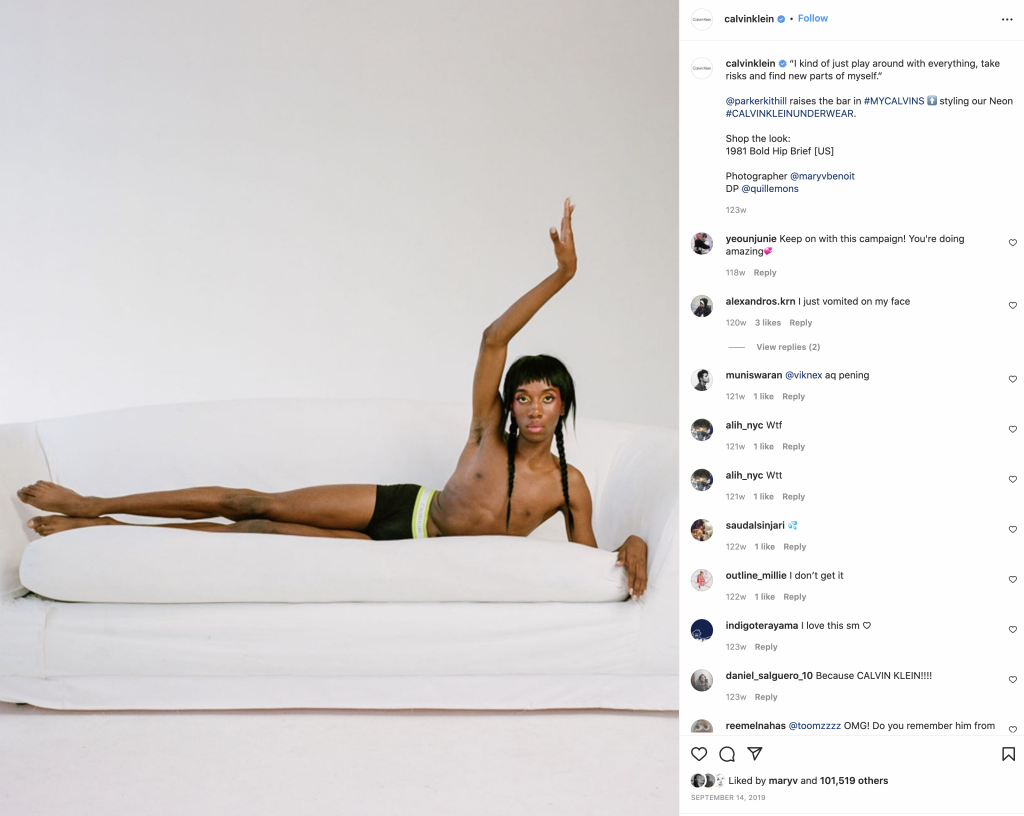Commodification
Samphe Ballamingie
Samphe Ballamingie is a documentary filmmaker and writer, sharing stories of climate justice, community organizing, and sustainable urban design.
Instagram’s Commodification of Identity
I used to be obsessed with Tumblr and Instagram star, Orion Carloto. She embodied the person I wanted to become: a proud Queer writer, photographer, and filmmaker. She was elegant and artistic. Scrolling through her Instagram feed, I would think: I want to be her. Or, more accurately, I want to have what she has. But upon closer examination, I realized that Carloto carefully orchestrated her lifestyle—the clothing she wore, the events she attended, and the photos she posted into an aesthetic that had the potential to be commodified (see Figure 1).
Carloto’s Instagram is not the only example of how a social media feed can be turned into a billboard. Corporate sponsorships often hide within the guise of online identities—expressed through art or fashion or sport. Growing up on/with/through the Internet, I felt my identity to be overwhelmingly tied to consumerism. As a teen, I expressed myself by purchasing clothing, jewelry, and makeup. If I saw an Instagram influencer sporting a new pair of earrings, I would look for similar earrings at H&M or Simons. Product placements woven into lifestyle posts commodify identity and spur an exchange of goods and services on the open market. This commodification of identity reflects the totalizing effect of capitalism.

Corporations also reach beyond A-list influencers: even the artists and activists I follow are recruited by brands, and their posts regularly include paid product placements. Calvin Klein hired photographer and performance artist, MaryV Benoit, to shoot an ad campaign portraying Queer people and their self-expressions (pictured in Figures 2 and 3, below). MaryV uses her online platform to advocate for better Queer and disabled representation in the media, and I was excited to see more diverse identities and bodies both in the online realm and on physical billboards. But behind this representation, I recognize how the commodification of Queer identity bolsters profit.
Instagram, owned by Meta, seeks to maximize its corporate profit, and as such, artists and activists engaging in this digital platform face serious limits in truth speaking and representation. I understand why MaryV would collaborate with Calvin Klein—it must have been lucrative to shoot a campaign with a popular clothing brand—but this speaks to Instagram’s limitations of representation: can Queer people only speak their truth as long as they generate corporate profit while doing so?


I felt particularly uneasy when Queer activist and model Rain Dove posted a photo with the caption:
Yessss I shot an amazing fashion campaign and can finally announce it! Zalando! For those of You who think the world isn’t changing or going to change let me tell You – older companies that have systematically erased us [Queer people] from their marketing world are dying out. New brands are being born and are coming to us to help them grow. For instance this company I did the campaign with is pretty new to the world but they already are growing exponentially and doing it the right way. During this shoot it wasn’t about pity porn. It was about handing over a microphone and collaborating with our communities. For instance they let me review and edit the script, choose my outfits, and write this blurb however I wanted to. They made sure that they didn’t just have a token queer person or a token person of color. […] That’s what the future of fashion should be about. Conscientious consumership. Conscientious marketing. […] (Dove, 2019).
While Dove’s experience seems to have been a positive one, at a broader scale, the transformation of personal identity is still being packaged into a polished image that other people—Queer or not—consume with ease. It does appear that marketers are working to include more diverse faces and voices than they did historically. However, like most everything that corporations do, the aim here is to make money—in this case, by selling an idea of progressiveness, based on a real person’s reality. In the case described above, a Queer person’s public persona has been commodified—incorporated into the mainstream, rather than acting in opposition or response to it. Queerness, rather than transforming capitalism, becomes transformed itself—into normativity, a normativity that is consumed like any other commodity.
Discussion Questions
- While commodification commonly refers to transforming natural resources into market goods, the same process can transform an individual’s social identity (age, gender, sexuality, ethnicity, race, etc.) into the demand for goods and services. What other non-physical things can be transformed in this way?
- How do social media profiles construct identity as a marketing tool, and to what effect?
- What other identities (beyond those described above) have been commodified, and how do they link self-expression with consumerism?
- How does the commodification of Queer (or other) identity have an impact on liberation movements? How does the commodification of identity distract us from the social change that liberation movements target?
Exercise
Keep a daily journal over the course of a week. Pay close attention as you consume print, broadcast, and social media. Continuously pose these questions: What do I see that I want to reflect in my own identity? What do I see that I want to own? How are corporations using identity to market products or services to me? Which aspects of identity are being commodified, how, and to what effect?
References
Carloto, O. (2019). @orionvanessa. Instagram. Retrieved from https://www.instagram.com/orionvanessa/?hl=en
Dove, R. @raindovemodel. Instagram. Retrieved from https://www.instagram.com/raindovemodel/?hl=en
MaryV. (2019) @maryv. Instagram. Retrieved from https://www.instagram.com/maryv/

